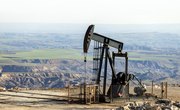
The first modern method of oil drilling developed by Edwin L. Drake in 1859 is still being used to this day, though the increased demand for petroleum products has required more efficient means of oil production. The world has used 800 billion barrels of oil since 1859, and oil drilling quickly became a booming industry. According to the US Department of Energy, new technologies are allowing drillers to reach oil reserves once considered unreachable.
Function
Oil wells are used to pump crude petroleum gases and oil from underground sources. Crude oil is a highly viscous liquid and very dark in color. In a semi-solid state, crude oil becomes tar. Geologists search for pockets of crude oil in underground reservoirs. These reservoirs can be hundreds and even thousands of feet underground and can only be reached by drilling beneath the surface. Once the drillers reach the reservoir, the change in pressure sends crude oil shooting to the Earth's surface. This is called "primary production." This process can continue for years, but most of the oil still remains in the reservoir. Once the pressure subsides, oil companies must use pumps to pull the crude oil up to the derrick.
.
Offshore Drilling
Offshore oil drilling is very similar to other methods used on land, except crewmen often live aboard these massive drilling ships. At depths less than 200 feet (61 meters) special oil drills called "jack up rigs" are used. Once the depths reach 4,000 feet (1,220 meters) the rigs are semi-submersible and are anchored to the ocean floor with air-filled legs. There are even drill ships that dig to depths of 8,000 feet (2,440 meters) and use sophisticated navigational equipment. However, offshore oil drilling has been a plague on the environment over the years. Major oil companies are constantly being accused of spilling oil and toxic chemicals in the water, releasing noxious gasses into the atmosphere and endangering wildlife near these drill sites. For example, Chevron has paid nearly 10 million dollars in fines between the years of 1992 and 1997 for numerous violations to the Clean Water Act.
Rotary Drilling
The most prevalent technique of drilling oil today is rotary drilling. This process can be recognized by a tall oil derrick and a rotating turntable at the base. A heavy bit is attached to a length of pipe. This pipeline is segmented and the drill depth can be increased by extending the length of the pipe. Rotary drilling also requires the use of a special mud which lubricates the drill bit, reinforces the sides of the drill hole, and helps pull out rock cuttings. The mud is a mixture of clay, water and chemicals.
Horizontal Drilling
Certain reservoir types are best reached through horizontal drilling. Directional drilling, as it was once called, was first used to reach oil or natural gas reservoirs once primary production had run its course at a vertical oil field. By drilling at a slant, deviating from the vertical oil wells, drillers could reach a greater amount of the reserve. It once took nearly 2,000 feet to make a full horizontal well. Now modern technology has improved the process, allowing for 90 degree turns in under a hundred feet. A successful horizontal drill can pump four times as much oil as a vertical well. Also, the cost of horizontal drilling is marginally lower across the board, in terms of a production-to-cost ratio. One horizontal well can do the work of four vertical wells.
Percussion Drilling
Percussion drilling, also called cable-tool drilling, is a simple method dating back to the very first drills used in the 1850s. The ground is broken by a drill bit attached to a pulley and cable. The drill bit is pulled to the top of the derrick and dropped to the ground repeatedly. This process shatters the rock into small pieces that can be cleared away to reveal a deep borehole. Percussion drilling can reach depths of over 328 feet (100 meters) and with exchangeable bits can be used to drill nearly any kind of surface. By the late 1800s, percussion drilling sites were aided by steam engines, but later got replaced by the rotary drill.
References
Resources
About the Author
Frederick S. Blackmon's love for fiction and theater eventually led to a career writing screenplays for the film and television industry. While living in Florida, Blackmon began exploring issues on global warming, health and environmental science. He spent two years as a Parkour and free-running instructor as well. Now he writes everything from how-to blogs to horror films.
